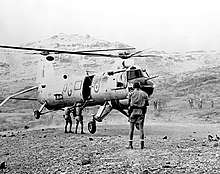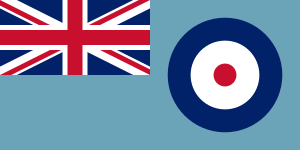RAF Khormaksar
Royal Air Force Khormaksar or more simply RAF Khormaksar is a former Royal Air Force station in Aden, Yemen. Its motto was "Into the Remote Places".[1] During the 1960s, it was the base for nine squadrons and became the RAF's busiest-ever station as well as the biggest staging post for the RAF between the United Kingdom and Singapore.
| RAF Khormaksar | |||||||
|---|---|---|---|---|---|---|---|
| Aden in Yemen | |||||||
 Motto: Into the Remote Places | |||||||
 RAF Khormaksar Shown within Yemen | |||||||
| Coordinates | 12°49′46″N 045°01′45″E | ||||||
| Type | Royal Air Force station | ||||||
| Site information | |||||||
| Owner | Ministry of Defence | ||||||
| Operator | Royal Air Force | ||||||
| Site history | |||||||
| Built | 1917 | ||||||
| In use | 1917 - 29 November 1967 | ||||||
| Airfield information | |||||||
| Identifiers | IATA: ADE, ICAO: OYAA | ||||||
| Elevation | 1 metre (3 ft 3 in) AMSL | ||||||
| |||||||

It later became Aden International Airport.
History
Established in 1917, RAF Khormaksar was enlarged in 1945 as the British spread their influence deeper into the Arabian Peninsula. In 1958, a state of emergency was declared in Aden as Yemeni forces occupied nearby Jebel Jehaf and RAF squadrons were involved in action in support of the British Army. In the 1960s, during operations around Rhadfan, the station reached a peak of activity, becoming overcrowded and attracting ground attacks by rebels. In 1966, the newly elected Labour government in the United Kingdom announced that all forces would be withdrawn by 1968. Khormaksar played a role in the evacuation of British families from Aden in the summer of 1967. The station closed on 29 November 1967.
Units and aircraft
| Unit | Dates | Aircraft | Variant | Notes |
|---|---|---|---|---|
| No. 8 Squadron RAF | Various | Various | See below | |
| No. 12 Squadron RAF | 1935 and 1936 | Hawker Hart | [2] | |
| No. 21 Squadron RAF | 1965-1967 | Douglas Dakota Hawker Siddeley Andover |
CC.2 |
|
| No. 26 Squadron RAF | 1963-1965 | Bristol Belvedere | HC.1 | |
| No. 37 Squadron RAF | 1957-1967 | Avro Shackleton | MR.2 | |
| No. 41 Squadron RAF | Oct 1935-Mar 1936 | Hawker Demon | Mk I | To Sheikh Othman Mar-Aug 1936 |
| No. 43 Squadron RAF | 1963-1967 | Hawker Hunter | FGA.9 | |
| No. 73 Squadron RAF | 1956 | de Havilland Venom | FB.1 | |
| No. 78 Squadron RAF | 1956-1967 | Scottish Aviation Pioneer Scottish Aviation Twin Pioneer Percival Pembroke Westland Wessex |
CC.1 C.1 CC.1 HC.2 |
|
| No. 84 Squadron RAF | 1956-1967 | Various | ||
| No. 94 Squadron RAF | 1939 | Gloster Gladiator | I and II | |
| No. 105 Squadron RAF | 1962-1967 | Armstrong Whitworth Argosy | C.1 | |
| No. 114 Squadron RAF | 1945 | de Havilland Mosquito | VI | Originally used the Douglas Boston |
| No. 203 Squadron RAF | 1940 | Bristol Blenheim | IV | |
| No. 208 Squadron RAF | 1961-1964 | Hawker Hunter | FGA.9 | also 1956 detached from RAF Akrotiri |
| No. 216 Squadron RAF | 1942 | Lockheed Hudson | VI | detached from Cairo West |
| No. 233 Squadron RAF | 1960-1964 | Vickers Valetta | C.1 | |
| No. 244 Squadron RAF | 1944 | Vickers Wellington | XIII | detached from Masirah |
| No. 259 Squadron RAF | 1943 | Consolidated Catalina | IB | detached from Dar es Salaam |
| No. 265 Squadron RAF | 1943 | Consolidated Catalina | IB | detached from Dar es Salaam |
| No. 413 Squadron RCAF | 1942-1945 | Consolidated Catalina | IV | detached from Koggala |
| No. 459 Squadron RAAF | 1942 | Lockheed Hudson | III | detached from LG227 and LG143 |
| No. 621 Squadron RAF | 1943-1945 | Vickers Wellington | XIII | |
| No. 683 Squadron RAF | 1951 | Vickers Valetta | C.1 | |
| No. 1417 Flight RAF | 1958-1960 | Gloster Meteor | FR.9 | |
| No. 1417 Flight RAF | 1963-1967 | Hawker Hunter | FR.10 / T.7 | |
| Aden Communication Squadron RAF | [3] | |||
| Aden Protectorate Communication and Support Squadron RAF | [3] | |||
| Headquarters British Forces Aden Communication Squadron RAF | [4] |
No. 8 Squadron RAF were based there on eight occasions:[5]
- 1927-1945 operating the Fairey IIIF, Vickers Vincent, Hawker Demon, Bristol Blenheim, Martin Maryland, Fairey Swordfish, Lockheed Hudson and Vickers Wellington
- 1946-1950 operating the de Havilland Mosquito, Hawker Tempest and Bristol Brigand
- 1950-1951 operating the Bristol Brigand, Avro Anson and Auster AOP6
- 1951-1952 as before
- 1952-1953 operating the Bristol Brigand and de Havilland Vampire
- 1953-1956 operating the de Havilland Vampire and de Havilland Venom
- 1956-1961 operating the de Havilland Venom, Gloster Meteor and Hawker Hunter
- 1960-1967 operating the Hawker Hunter FGA.9 and T.7
- 1960-1963 operating the Hawker Hunter FR.10
No. 84 Squadron RAF were based between 1956 and 1967 and operated the Vickers Valetta, Bristol Sycamore, Percival Pembroke, Blackburn Beverley and Hawker Siddeley Andover.
See also
- British Forces Aden
- Air Forces Middle East
References
Citations
- Pine, L.G. (1983). A dictionary of mottoes (1 ed.). London: Routledge & Kegan Paul. p. 115. ISBN 0-7100-9339-X.
- Jefford 1988, p. 28.
- Lake 1999, p. 9.
- Lake 1999, p. 128.
- Ashworth, Chris (1989). Encyclopaedia of modern Royal Air Force squadrons. Wellingborough: Stephens. pp. 43–45. ISBN 1-85260-013-6.
Bibliography
- Jefford, C G (1988). RAF Squadrons. A comprehensive record of the movement and equipment of all RAF squadrons and their antecedents since 1912. Shrewsbury: Airlife. ISBN 1-85310-053-6.
- Lake, A (1999). Flying units of the RAF. Shrewsbury: Airlife. ISBN 1-84037-086-6.
- Sturtivant, Ray, ISO and John Hamlin. RAF Flying Training And Support Units since 1912. Tonbridge, Kent, UK: Air-Britain (Historians) Ltd., 2007. ISBN 0-85130-365-X.
